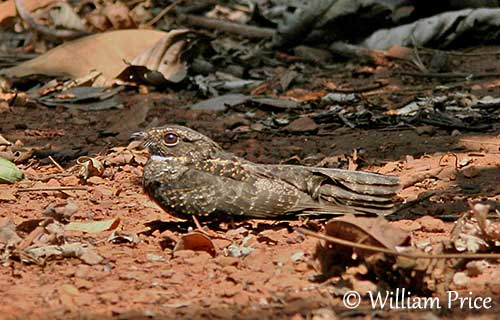
Fr: Engoulevent noirâtre
Ang: Blackish Nightjar
All: Trauernachtschwalbe
Esp: Chotacabras Negruzco
Ita: Succiacapre nerastro
Nd: Roetnachtzwaluw
Sd: sotnattskärra
Photographers:
Roger Ahlman
Pbase Galleries Peru and Ecuador
Ken Havard
My Bird Gallery & Flickr gallery 1 & Flickr gallery 2
Patrick Ingremeau
TAMANDUA
William Price
PBase-tereksandpiper & Flickr William Price
Text by Nicole Bouglouan
Sources:
HANDBOOK OF THE BIRDS OF THE WORLD Vol 5 by Josep del Hoyo-Andrew Elliott-Jordi Sargatal - Lynx Edicions - ISBN: 8487334253
NIGHTJARS - A Guide to Nightjars and Related Nightbirds – Nigel Cleere and Dave Nurney - Yale University Press - First Edition (August 11, 1998) - ISBN 10: 0300074573 / ISBN 13: 9780300074574
A GUIDE TO THE BIRDS OF COLOMBIA by Steven L. Hilty and William L. Brown - Princeton University Press – ISBN 069108372X
SORA - Vulnerability of Eggs and Young of the Blackish Nightjar (Caprimulgus nigrescens) in Suriname
Arthur Grosset's Birds (Arthur Grosset)
Fatbirder - Caprimulgidae – Nightjars & Nighthawks
Blackish Nightjar
Nyctipolus nigrescens
Caprimulgiformes Order – Caprimulgidae Family
INTRODUCTION:
The Blackish Nightjar is a small, very dark nightjar found in the Amazon Basin where it frequents open stony country with rocky outcrops in and along rivers, shrubby clearings and open savanna with sparse bushy vegetation.
It typically feeds on insects. It has nocturnal habits but by day, it roosts on the ground or rocks, often under thickets.
It nests on the bare ground or on granite rock, but usually close to vegetation. Both parents share the nesting duties.
The Blackish Nightjar is described as fairly common, but it is patchily distributed. But currently, the species is not globally threatened.
DESCRIPTION OF THE BIRD:
Biometrics:
Length: 20 cm
Weight: M: 32-42 g – F: 32-50 g
The Blackish Nightjar adult male is small and very dark, mostly blackish-brown.
The upperparts are blackish with tawny, cinnamon, buff and greyish-white mottling. The wing-coverts are similar with speckles and spots. The scapulars are blackish-brown with tawny spots and buff edges.
On the wings, the male has small, white spot on second, third and fourth outermost primaries. On the tail, there are white tips to second and third outermost rectrices.
The underparts are dark brown with paler bars and spots, but lower belly and flanks are buffish and barred brown.

On the head, we can see an indistinct pale, dotted eyebrow and a small, white patch on each side of the lower throat. There is sometimes a narrow, white collar across the lower throat.
The bill is blackish. The eyes are dark brown. Legs and feet are dark brown.
The female is all dark except for narrow (often incomplete) white band on lower throat. The white markings on wings and tail are absent.
Juvenile and immature resemble adults, but they are slightly paler. The upperparts often appear tinged vinaceous, whereas the underparts are cinnamon.
RANGE:
The Blackish Nightjar is resident throughout its range E of the Andes, from E Colombia, across large parts of Amazonian Brazil, N to S Venezuela and the Guianas, and S to Bolivia.
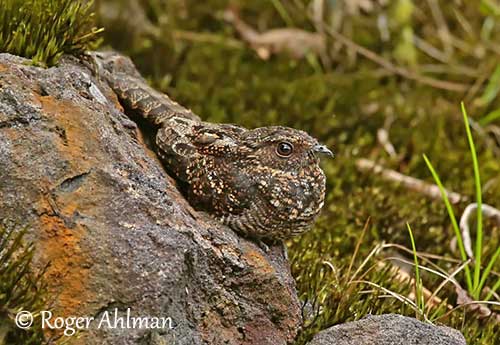
HABITAT:
The Blackish Nightjar frequents open country with rocky places, both in and along rivers, and granite outcrops with sparse vegetation. It is also found in rainforest, second growth and open savanna with some scattered bushes.
When it is away from rocky places, it can be found near tracks, roads, clearings and on recently burnt ground.
The species is visible between 100 and 1,100 metres of elevation, although nests have been found in Ecuador, up to 1,350 metres of elevation.
CALLS AND SONGS: SOUNDS BY XENO-CANTO
The Blackish Nightjar gives guttural hissing during both defence and distraction behaviour. When alarmed or threatened, it gives a short, sharp “ptink” or “prek”.
It sings from perches on rocks, trees and bushes, especially throughout the night. The song is a soft, purring “pru-r-r-r-t” or “qu-r-r-r-t” and these notes are repeated 2-5 times in about 4 seconds or more in quick succession.
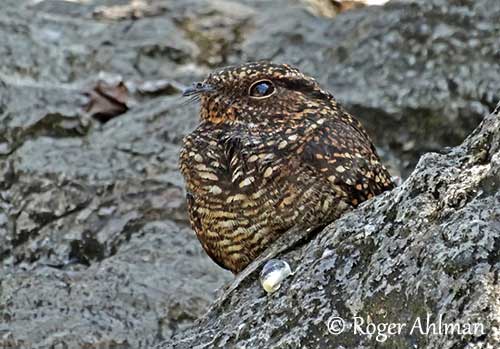
BEHAVIOUR IN THE WILD:
The Blackish Nightjar feeds on insects, especially moths and beetles, including Elateridae species.
It forages above the tree canopy, but also lower over the rocky outcrops. It is mostly active at dusk and dawn or at night.
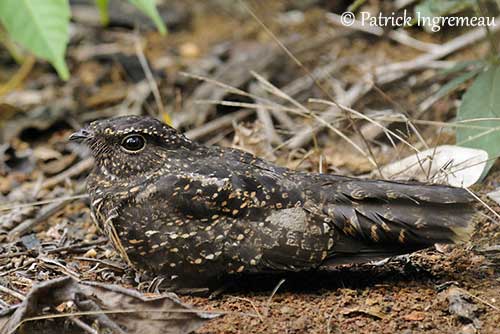
The Blackish Nightjar spends the day roosting on the ground under thickets, but also on exposed rocks and boulders, especially in the middle of rivers.
It becomes active at dusk and returns to the roost site at dawn. If threatened, it adopts a flattened posture and closes the eyes. It also bobs up and down while giving alarm calls before to leave the roosting site.
The male performs courtship displays to attract a female by displaying the white markings of the tail while angling it towards her. The female may sometimes gape widely. During this behaviour, both mates utter soft, purring “pru-r-r-r-t” sounds. They usually roost together, side by side.
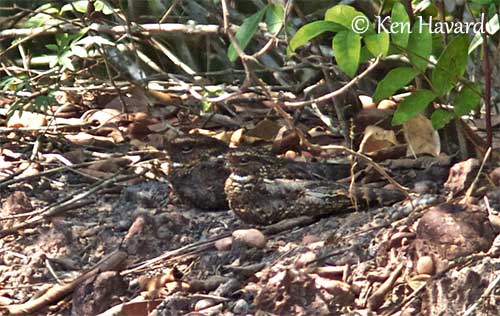
The Blackish Nightjar is resident throughout its wide range.
It leaves the roost in series of short flights but it flies only a short distance before re-alighting. In flight, the wings appear rounded.
REPRODUCTION OF THIS SPECIES:
The breeding season takes place in May-August in Guyana, and February-March and August-November in Surinam, coinciding with the dry season. It occurs in September-October in Bolivia and in August-November in W Brazil.
The Blackish Nightjar does not build a nest and the eggs are laid directly on sandy soil, bare ground or leaf litter, sometimes in shallow scrape and also on bare granite rock. The nest-site is usually near vegetation.
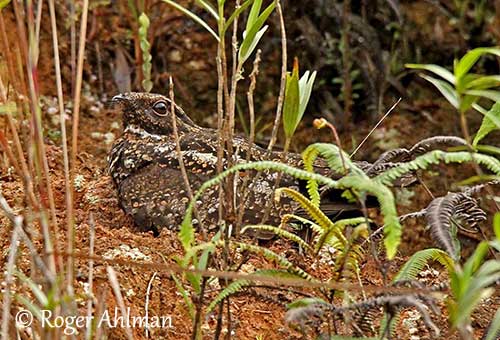
The female lays a single creamy-buff, pinkish-buff or reddish-brown egg with brown and grey spots and blotches. A replacement clutch is laid if the first is lost. Both adults share the incubation during 17 days, although there is a record of 22 days in the Ecuadorian Andes, probably due to the cold temperatures at higher elevation. At hatching, the chick is covered in pale greyish down.
Depending on the nest-site, the eggs laid on open rock may become overheated if the adults are absent for long period. On the other hand, the eggs laid in shallow depression in rock may be totally immersed in rainwater during showers. However, the immersed egg is still incubated because the water evaporates quickly from the warm rock.
If the nest is threatened, the adults perform distraction display, usually injury-feigning display.
The chick is able to move over several metres by hopping when a parent calls it. It fledges two weeks after hatching and leaves the nesting area at 16-18 days old.

PROTECTION / THREATS / STATUS:
The Blackish Nightjar has a large range in which it is described as locally abundant in suitable habitat, but it is patchily distributed.
The species is affected by human disturbance on trails and roads.
The size of the population is unknown, but it is suspected to be stable.
The Blackish Nightjar is not globally threatened, and the species is currently evaluated as Least Concern.
